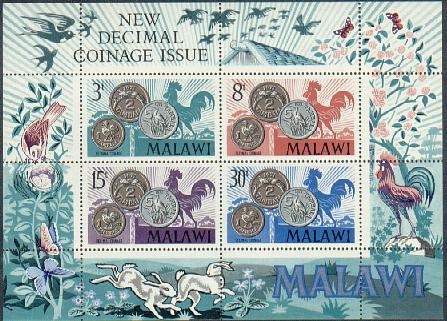The United States instituted decimal coinage* (1 dollar = 100 cents) in 1786. Now virtually all nations** have decimal currencies, for example: the euro system (1 euro = 100 cents) throughout much of Europe. At one time a major currency around the world was the British system of pounds, shillings, and pence (sometimes including the guinea and the farthing). That system consisted of: 1 pound = 20 shillings = 240 pence (1 shilling = 12 pence).
* Sources attribute the monetary system instituted by Russia’s Peter the Great as a century ahead of most others in that it was based on the decimal system. See for example http://www.library.yale.edu/slavic/coins/html/peter1.html. On the other hand, see http://www.secretservice.gov/money_history.shtmlfor information on the U.S. becoming the first country in the world to adopt the decimal system for currency.
** Two countries do not use decimal monetary systems: (1) In Mauritania (in northwestern Africa, bordering on the Atlantic Ocean) the ouguiya is divided into 5 khoums. Khoums are very small value compared to the U.S. dollar (1 ouguiya ~ 0.4 U.S. cents, 1 khoums < 0.1 U.S cent) and are probably not used outside of the country or exchanged for other currencies; (2) In Malagasy (off the coast of southeast Africa, in the Indian Ocean) the ariary is divided into 5 iraimbilanja. Similarly, the iraimbilanja has a very small value (1 ariary ~ 0.05 U.S. cents, 1 iraimbilanja ~ 0.01 U.S. cent) and appears to be used only within the country.
All former British Commonwealth nations that once had non-decimal money have switched to decimal currencies. Often the switch accompanied independence for those nations. For most nations it was a matter of adopting a decimal currency to come in line with the dominant decimal nature of world commerce and trade. Those new decimal currencies often took the form of either dollars and cents or decimal pounds and new pence (1 pound = 100 new pence). However, decimal currencies also exist under many other names.
The image below is a postal souvenir sheet issued by Malawi in 1971 when they converted to decimal currency. The sheet shows Malawi’s new decimal (1, 2, and 5 tambala) coins.

The table below lists countries that have switched to decimal currencies after having used non-decimal money. Many, but not all, of these countries used the former British system of pounds, shillings, and pence.
Countries that have switched to decimal currencies:
| Year | Country or Countries |
|---|---|
| 1935 | Trinidad and Tobago |
| 1949 | Dominica, Grenada, St. Lucia (Island), St. Vincent (Island) |
| 1950 | Barbados |
| 1951 | Aden, Antigua (Island), British Virgin Islands, Montserrat, St. Kitts-Nevis (Islands), Somaliland Protectorate (now part of Somalia) |
| 1953 | Burma |
| 1955 | Cyprus |
| 1957 | Bahrain, India, Kuwait |
| 1958 | Nepal |
| 1961 | Basutoland (now Lesotho), Bechuanaland Protectorate (now Botswana), Pakistan, South Africa, South West Africa (now Namibia), Swaziland |
| 1962 | Uganda |
| 1964 | Sierra Leone |
| 1965 | Ghana |
| 1966 | Australia, Bahamas, Gilbert and Ellice Islands, Nauru (Island), Norfolk Island, Papua New Guinea, Solomon Islands |
| 1967 | Cook Islands, New Zealand, Niue (Island), Pitcairn Island, Rhodesia (now Zimbabwe), Samoa, Tokelau (Islands), Tonga |
| 1968 | Zambia |
| 1969 | Cayman Islands, Cocos Islands, Fiji, Jamaica, Turks and Caicos Islands |
| 1970 | Bermuda, Malawi, Oman |
| 1971 | Ascension (Island), British Antarctic Territory, Falkland Islands, Gambia, Gibraltar, Ireland, St. Helena (Island), South Georgia (Island), Tristan Da Cunha (Islands), United Kingdom |
| 1972 | Aitutaki (Island), Malta |
| 1973 | Nigeria |
Decimal currency is desirable …
“because by that means all calculations of interest, exchange, insurance, and the like are rendered much more simple and accurate, and, of course, more within the power of the great mass of people. Whenever such things require much labor, time, and reflection, the greater number who do not know, are made the dupes of the lesser number who do.”
Robert Morris, the U.S. Superintendent of Finance, writing to Congress in 1782
Back to USMA home.
Copyright © 1998-2006, US Metric Association (USMA), Inc. All rights reserved.
Updated: 2006-09-29